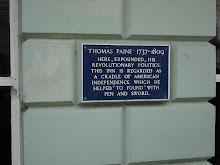

I am reminded over on Philip Wilkinson's excellent blog 'English Buildings' of the plotland developments which took place in various parts of England. As this blog is named for one such, it's worth a mention. New Anzac-on-Sea was the prizewinning name resulting from a competition, set by Charles Neville, to christen his baby town. Later of course it became Peacehaven, a place reviled by planners throughout the land. Some plotlands grew up as a result of like-minded religious or political groups wishing to establish very basic self-sufficient communities. The homes they built were often rudimentary and made from that most adaptable of materials, corrugated iron - often redundant railway carriages were purchased and, devoid of their wheels, set Rowland Emmett-like upon railway sleepers - to my mind a most attractive and commodious dwelling. A wonderful hangover of this 'adaptation' still sits, not in a plotland at all, but in the chocolate box village of Slindon West Sussex, where one such carriage is wonderfully preserved and thatched to blend into its surroundings. Peacehaven however was born of no such social or altruistic intentions, rather it was the brainchild of the entrepreneur Charles Neville a land speculator whose sometimes questionable interests had taken him to Canada, Australia and beyond. During the Great War he purchased his first tract of land which comprised some of the coastal strip running from Rottingdean in the West to just shy of Newhaven in the East. Ever the grand publicist Neville used press advertising and direct marketing to great effect and one of his first stunts was to run a competition to name what he would later describe as his 'Garden City by the Sea' and from some 80,000 entries, the name 'New Anzac-on-Sea' was chosen, it is said as a tribute to the Australian and New Zealand Army Corps who served so valiantly in France. The prize for naming was £100 and the runners-up were to receive building plots to the value of £50 each...the straws were in the wind however and instead of there being just a few second prizes, there were 12,500! and these were then asked to pay various 'registration fees' . Once these were gathered in the number of takers dropped considerably and eventually Neville made a considerable profit on his 'Free' plots. Subsequently with the backing of The Daily Express 150 plotholders succeeded in suing him for fraud and he was forced to pay back his ill gotten gains. Ever the fighter, Neville counter-sued the Express for libel and won £300 damages. This then was the inauspicious birth of 'The Garden City by the Sea' - I will return to its history for as well as being an object lesson in how not to plan a town, some of its early social manifestations were luadable in their intent. As I think John Seymour said, what was so awful that men returning from the horrors and carnage of The Great War should spendtheir pathetic little gratuities in an attempt to find calm for their souls and troubled minds in such a perfect South facing strip of Sussex downland.
By the way, the picture of the thatched railway carriage is by Simon Carey and used under The Creative Commons licence.

10 comments:
Great post, Jon, and thanks for the mention! I especially enjoyed the thatched railway carriage, which I'd not seen before.
Turning a rail carriage into a home reminded me of the Glenfinnan Station Museum. Here one can rent out a sleeper carriage to use as a base for touring Scotland. Another fine use for old rolling stock.
Thanks Philip...and I do like the idea of the sleeper carriage, Ted. We had a similar experience in The Napa Valley a few years ago where old railroad cabooses had been converted for the same purpose
Oh Gawd ! Once again Jon,you have succeeded in unsettling me with this lovely post........In about 1958 when I was about 10 my family stayed in a B&B in Felpham which was a converted railway carriage......And then about 10 years later I discovered another one at the very end of the East Beach at Selsey near Pagham..This was very flash....The owners had a Ferrari GTB4!
Now 40 years on I want that rubber clad beach house on Dungeness and its Airstream trailer..Old habits die hard...And they reckon "Glamping"is a new phenomenon?
Hah !
Bucks...we have chums here in Northern New Anzac who have a most charming late 19th century carriage in their garden. They use it for overspill accommodation when friends would otherwise swamp their small cottage, and it's wonderful. With a view down to the sea and across to Newhaven, as you take a leisurely cup of tea, this is what the original 'plotland' experience must have been like. Get thee to Slindon next time you're at Goodwood!
10-4,good buddy!
Brilliant post, thank you so much. Being ancient I can just remember the camping coaches which were on sidings at both Dawlish Warren in Devonshire and at Marazion in Cornwall. But thatched....?!
Not old Ron, merely maturing. I think those blokes who do volunteer work on old steam railways have similar sleeping arrangements in redundant (no longer) rolling stock in sidings.
Super post, Jon.
I've always wanted an old railway carriage as an office. There used to be a bed and breakfast place somewhere in Derbyshire where the bedrooms were adapted railway carriages, it was lovely.
Post a Comment